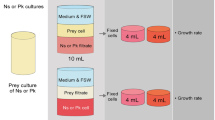Abstract
The dominant purple sulfur bacterium of laminated sediment ecosystems in temperate environments, Thiocapsa roseopersicina, was cultivated in sulfide-limited continuous cultures (D=0.03 h-1) subjected to various combined diel regimen of aeration and illumination in order to simulate environmental conditions in microbial mats. For comparison, cultures were grown under similar illumination regimens but continuously anoxic conditions.
Bacteriochlorophyll a (BChla) and carotenoid synthesis was restricted to anoxic-dark periods and did not occur during oxic-light periods. An increase in the length of the oxic-light periods resulted in decreased pigment contents. However, phototrophic growth remained possible even at 20 h oxic-light/4 h anoxic-dark regimens. When anoxic conditions were maintained throughtout, BChla synthesis occurred both during light and dark periods.
Glycogen was synthesized in the light and degraded in the dark. Calculations showed that degradation of 1/4–1/5 of the glycogen is sufficient to account for the BChla and carotenoid synthesis in the dark.
The data showed that T. roseopersicina is very well adapted to cope with the combined oxygen and light regimes as they occur in microbial mats, which may explain the dominance of this bacterium in the purple layer of these sediment ecosystems.
Similar content being viewed by others
Abbreviations
- BChl:
-
bacteriochlorophyll
- μ:
-
specific growth rate
- D:
-
dilution rate
- SR :
-
concentration of limiting substrate in reservoir bottle
References
Avissar Y, Ormerod JG, Beale SI (1989) Distribution of δ-aminolevulinic acid biosynthetic pathways among phototrophic bacterial groups. Arch Microbiol 151: 513–519
Beeftink HH, VanGemerden H, (1979) Actual and potential rates of substrate oxidation and product formation in continuous cultures of Chromatium vinosum. Arch Microbiol 121: 161–167
Chen KF, Morris JC (1972) Oxidation of sulfide by O2-catalysis and inhibition. J Sanit Eng Div Am Soc Civ Eng 98: 215–227
DeWit R, VanGemerden H (1987) Chemolithotrophic growth of the phototrophic sulfur bacterium Thiocapsa roseopersicina. FEMS Microbiol Ecol 45: 117–126
DeWit R, VanGemerden H (1990) Growth of the phototrophic purple sulfur bacterium Thiocapsa roseopersicina under oxic/anoxic regimens in the light. FEMS Microbiol Ecol 73: 69–76
DeWit R, Jonkers HM, Van denEnde FP, VanGemerden H (1989) In situ fluctuations of oxygen and sulphide in marine microbial sediment ecosystems. Neth J Sea Res 23: 271–281
Fairbairn NJ (1953) A modified anthrone reagent. ChemInd 1953: 86
Foppen FH (1971) Tables for the identification of carotenoid pigments. Chromatogr Rev 14: 133–298
Herbert RA (1985) Development of mass blooms of photosynthetic bacteria on sheltered beaches in Scapa Flow, Orkney Islands. Proc R Soc Edinburgh 87 B: 15–25
Herbert D, Phipps PJ, Strange RE (1971) Chemical analyses of microbial cells. In: Norris JR, Ribbons BW (eds) Methods in microbiology, vol 5 B. Academic Press, London, pp 209–344
Kern M, Klemme JH (1989) Inhibition of bacteriochlorophyll biosynthesis by gabaculin (3-amino, 2,3-dihydrobenzoic acid) and presence of an enzyme of the C5-pathway of δ-aminolevulinate synthesis in Chloroflexus aurantiacus. Z Naturforsch 44c: 77–80
Krasil'nikov EN, Petushkova YP, Kondrat'eva EN (1976) Growth of the purple sulfur bacterium Thiocapsa roseopersicina in the dark under anaerobic conditions. Microbiology 44: 631–634
Kuenen JG, Robertson LA, VanGemerden H (1985) Microbial interactions among aerobic and anaerobic sulfur-oxidizing bacteria. In: Marshall KC (ed) Advances in microbial ecology, vol 8, Plenum Press, New York, pp 1–59
Law JH, Slepecky RA, (1961) Assay of poly-β-hydroxybutyric acid. J Bacteriol 82: 33–36
Lowry OH, Rosebrough NJ, Farr AL, Randall RJ (1951) Protein measurements with the Folin phenol reagent. J Biol Chem 193: 265–275
Nicholson JAM, Stolz JF, Pierson BK (1987) Structure of a microbial mat at Great Sippewissett Marsh, Cape Cod, Massachusetts. FEMS Microbiol Ecol 45: 343–364
Schmidt K (1978) Biosynthesis of carotenoids. In: Clayton RK, Sistrom WR (eds) The photosynthetic bacteria. Plenum, New York, pp 729–750
Stal LJ, VanGemerden H, Krumbein WE (1984) The simultaneous assay of chlorophyll and bacteriochlorophyll in natural microbial communities. J Microbiol Methods 2:295–306
Steudel R, Göbel T, Holdt G (1988) The molecular composition of hydrophilic sulfur soils prepared by acid decomposition of thiosulfate [1]. Z Naturforsch 43b: 203–218
Steudel R, Holdt G, Visscher PT VanGemerden H (1990) Search for polythionates in cultures of Chromatium vinosum after sulfide incubation. Arch Microbiol 153: 432–437
Trüper HG, Schlegel HG (1964) Sulphur metabolism in Thiorhodaceae. I. Quantitative measurements on growing cells of Chromatium okenii, Antonie van Leeuwenhoek J Microbiol Serol 30: 225–238
VanGemerden H (1968) On the ATP generation of Chromatium in darkness. Arch Mikrobiol 64: 103–110
VanGemerden H (1984) The sulfide affinity of phototrophic bacteria in relation to the location of elemental sulfur. Arch Microbiol 139: 289–294
VanGemerden H, Beeftink HH (1978) Specific rates of substrate oxidation and product formation in autotrophically growing Chromatium vinosum cultures. Arch Microbiol 119: 135–294
VanGemerden H, Tughan CS, DeWit R, Herbert RA (1989a) Laminated microbial ecosystems on sheltered beaches in Scapa Flow, Orkney Islands. FEMS Microbiol Ecol 62: 87–102
VanGemerden H, DeWit R, Tughan CS, Herbert RA (1989b) Development of mass blooms of Thiocapsa roseopersicina on sheltered beaches on the Orkney Islands. FEMS Microbiol Ecol 62: 111–118
Author information
Authors and Affiliations
Rights and permissions
About this article
Cite this article
de Wit, R., van Gemerden, H. Growth and metabolism of the purple sulfur bacterium Thiocapsa roseopersicina under combined light/dark and oxic/anoxic regimens. Arch. Microbiol. 154, 459–464 (1990). https://doi.org/10.1007/BF00245228
Received:
Accepted:
Published:
Issue Date:
DOI: https://doi.org/10.1007/BF00245228




